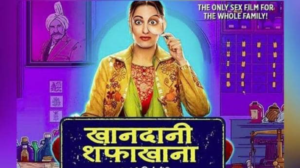The unpredictable litigations accompanying a film release makes me wonder if this is secretly a part of the marketing and promotion strategy of the film to be released!
In this post we will discuss the judgment passed by the Hon’ble Delhi High Court pertaining to the Sonakshi Sinha starrer ‘Khandani Shafakhana’.
A. IN A NUTSHELL
(i) The plaintiff on the facts pleaded was not found entitled to reliefs of permanent or mandatory injunction or for recovery of any damages from the defendant.
(ii) Suit was dismissed and no costs were imposed.
B. INTRODUCTION
Who is the plaintiff?
The plaintiff is an eminent Ayurvedic Sexologist and the son of Late Hakim Hari Kishan Lal Abbot who was a world renowned sexologist and had his practice set up in Delhi.
Registered trademarks of the plaintiff
The plaintiff had two (then registered) device mark bearing nos. 164663 and 213916, each in class-5 (medical preparation). However, the status of both registrations as of 15th July, 2019, reflected as ‘removed’.
What are the key issues raised by the plaintiff?
(i) Suit was filed by the plaintiff for an order of permanent injunction to restrain the defendants from releasing the film bearing title ‘khandani shafakhana’ as the same was infringing the proprietary rights of the plaintiff.
(ii) The movie repetitively used the portrait of the character in the film which is similar and can be confused with the portrait of the plaintiff’s father.
[note: the family members of the plaintiff had agreed amongst themselves that all members of the family shall be allowed to use the photograph of the late Hakim Hari Kishan Lal Abbot on their respective sign boards.]
(iii) The defendants had allegedly indulged in passing off and misappropriation of the business reputation of the plaintiff.
C. ARGUMENTS OF THE PLAINTIFF
The plaintiff had raised several concerns with respect to character resemblance and/or scenes of the film that were infringing the proprietary rights of the plaintiff and/or diminishing the goodwill of the plaintiff.
Some of the points that open room for legal learning have been mentioned below:
(i) The plaintiff cannot be said to have abandoned the mark ‘khandani shafakhana’ because the said abandonment was not voluntary.
(ii) The removal of the aforesaid marks from the registry is of no avail as the same can be restored belatedly.
(iii) The film is defamatory in nature for reasons argued by the plaintiff and tarnishes the reputation of the plaintiff.
D. ARGUMENTS OF THE DEFENDANTS
The points specific to the film and character have been satisfactorily replied to by the defendant and recorded in the judgment.
Some of the points for legal discussion are mentioned below:
- The plaintiff has not been connected to the mark ‘khandani shafakhana’ pursuant to an order in operation of the court since the year 2001.
- The film is socially relevant and raises the issues of need for sex education and treatment of sexual disorders.
- The reference in the film to the man whose photograph appears on the posters is only for a period of five to six minutes of a film of over two hours and was introduced only to show how the lady protagonist of the film got the clinic.
- The plaintiff had pleaded similarity in its plaint only by citing the upward curved greased moustache, peshwari looks, colour of the turban, handlebar moustache and facial posture, and in which there can be no proprietary rights and which are generic.
- Even though the plaintiff argued on the aspect of defamation, the plaint does not disclose any cause of action for defamation and is silent on this regard.
- The suit was filed on the ground of passing off and has to be decided on the said anvil only.
- No injunction for protection of marks which lapsed in the years 2005 and 2010 and which have admitted not been in use since 2001, can be granted.
- The plaintiff could not have afforded any delay for injuncting release of film as the trailer of the film was released on 21st June, 2019 and the suit was only filed on 17th July, 2019.
- The plaintiff had not made out any case of irreparable loss or injury; rather by filing the application under Order II Rule 2 of the CPC, the plaintiff has admitted that the damage even if any can be quantified in terms of money.
- The film, rather than causing any damage to the plaintiff, takes the reputation, if any, of the plaintiff forward.
E. FINDING OF THE COURT
The Hon’ble Mr. Justice R. S. Endlaw ruled in favour of the defendants as under:
- Pursuant to attending a screening of the film, Justice Endlaw in his judgment recorded that if anyone can take offence to the contents of the film, it should be lawyers and judges whose depiction is ridiculed in the film. However, this remark was backed with a rather practical sense of understanding that such scenes are dramatized to keep the interest of the viewers alive.
- The film provides for a golden opportunity to the plaintiff and alike practitioners to approach the larger cross section of the society on the subject of need to impart sex education and for lifting the stigma and taboo attached to sexual diseases/dysfunction/disorder and treatment thereof and to commence a countrywide dialogue from the platform offered by the film.
- The words ‘Khandani Shafakhana’ singly as well used in conjunction with each other are generic words. Therefore, one person even if running his medical clinic in the name and style of ‘khandani shafakhana’, cannot prevent another, from using the generic word ‘khandani’ or ‘shafakhana’ for a hospital or a medical clinic.
- The portrait of the father of the plaintiff, which the plaintiff claims is still in use cannot be mistaken as the portrait on the posters of the film of a well known actor.
- Justice Endlaw had referred to several judgments and laid down the following principles:
- that the effect of the allegedly offending words / visuals is to be judged from the standards of a reasonable / strong minded, firm and courageous man and not those of weak and vacillating minds nor of those who scent danger in every hostile point of view;
- that any restrictions imposed on expression of artistic thought, affects the constitutional right of the film makers;
- our society is a very mature society and there is no need for anyone to be sensitive;
- that the standards that we set for our censorship must make a substantial allowance in favour of freedom, thus leaving a vast area for creative art to interpret life and society, with some of its follies along with what is good;
- we must not look upon certain aspects, as banned in toto and forever from human thought and must give scope for talent to put them before the society;
- the requirements of art and literature include within themselves, a comprehensive view of social life, not only in its ideal form;
- a film that illustrates consequences of social evil, necessarily must show that social evil;
- a film is to be judged in its entirety, from the point of view of its overall impact;
- a feature film is a work of fiction and is exhibited for commercial purposes;
- the Constitution protects the rights of the artist to portray social reality in all its forms; some of that portrayal may take the form of questioning values and morals that are prevalent in the society;
- films are a legitimate and important medium for the treatment of issues of general concern and it is open to a producer to project his own message, even if it is not approved by others;
- freedom of expression is of inestimable value in a democratic society based on the rule of law;
- right to communicate and receive ideas, facts, knowledge, information, beliefs, theories, creative and emotive impulses by speech or by written word, drama, theatre, dance, music, film etc. is an essential component of the protected right of freedom of speech and expression;
- humour cannot be divorced from reality; we can laugh only in the context of what is known to us and not in abstract; if it were to be held that there can be no contextual humour as the same is bound to be considered to be offensive by someone or the other in the know of the context, there indeed would be no humour and it will indeed be a sad day;
- our commitment to freedom of expression demands that it cannot be suppressed unless the situations created by allowing that freedom are pressing and the community interest is in danger; anticipated danger should not be remote, conjectural or far-fetched – it should have proximate and direct nexus with the expression and the expression to which objection is taken should be equivalent of a spark in a powder keg;
- freedom of speech and expression is sacrosanct and the said right should not be interfered with; when the Central Board of Film Certification (CBFC) has granted the certificate and only something with regard to the petitioner which was shown in the media is being reflected in the film, the Court should restrain itself and not grant injunction;
- a film is a creation of art; an artist has his own freedom to express himself in a manner which is not prohibited in law and such prohibitions are not read by implication, to crucify the rights of expressive mind;
- like human beings, literary work produced by the author or the work of entertainment produced by a producer needs a title to be identified;
- title alone of a literary work cannot be protected by Copyright Law;
- protection of literary titles lies in the field of trade mark and unfair competition;
- titles may relate to two types of works i.e. titles of single literary works and titles of series of literary works;
- titles of series of books, periodicals or newspapers do function as a trade mark, to indicate that each edition comes from the same source as the others and constitute a trade mark;
- titles of single literary work do not enjoy trade mark protection and in order to become entitled to this protection, it is necessary to prove that such a title has acquired Secondary meaning i.e. title is capable of associating itself with particular work or source;
- only if it is so, would the likelihood of confusion of source, affiliation, sponsorship or connection in the minds of potential patrons arise;
- else, each literary work is a specific, separate and unique commercial item and not as one product among many competing products; and,
- the evidence necessary to establish secondary meaning of literary work is evidence of an audience educated to understand that the title means the work of a particular artist; such evidence includes the length and continuity of use, the extent of advertising and promotion and the amount of money spent and the closeness of the geographical and product markets of the plaintiff and defendants.
F. CONCLUSION
Sensitivity towards issues in the media and entertainment industry has led to litigations plummeting through the sky! Some of them bringing worthy learning and some reiterating well settled principles of law.
Do you think frequent imposition of costs would serve as a deterrent to unnecessary litigations in the future?
Image source – from here

















![No copyright in a film title- Lyca Productions appeals against single bench order restraining them to use title ‘Karu’ [READ JUDGEMENT]](https://iprmentlaw.com/wp-content/uploads/2018/02/karu-1-100x70.jpg)
![Madras High Court restrains Lyca Productions from using the title ‘Karu’ for its film [READ ORDER]](https://iprmentlaw.com/wp-content/uploads/2018/02/karu-100x70.jpg)